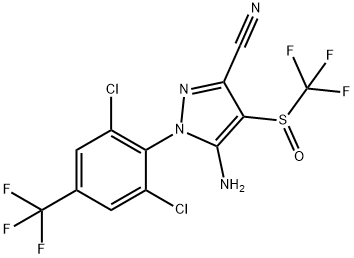
120068-37-3
- Product Name:Fipronil
- Molecular Formula:C12H4Cl2F6N4OS
- Purity:99%
- Molecular Weight:437.15
Product Details:
CasNo: 120068-37-3
Molecular Formula: C12H4Cl2F6N4OS
Appearance: White to Light Yellow Solid
Delivery Time: 2 weeks after order
Throughput: 100KG/Month
Purity: 99%
Synonyms: 4-((trifluoromethyl)sulfinyl)-; PRINCE; REGENT; 5-Amino-1-[2,6-dichloro-4-(trifluoromethyl)phenyl]-4-[(trifluoromethyl)sulfinyl]-1H-pyrazole-3-carbonitrile
Boiling point: 510.1±50.0 °C at 760 mmHg
Density: 1.9±0.1 g/cm3
Flash point: 262.3±30.1 °C
Vapor pressure: 0.0±1.3 mmHg at 25°C
Solubility: DMSO: 250 mg/mL (571.89 mM)
Refractive index: 1.618
Pka: -5.86±0.20
Description:
Fipronil is a white powder with a mouldy odour. It has a low solubility in water and is a slow-acting poison. It does not bind strongly with soil, and the half-life of fipronil– sulphone is 34 days. Fipronil is a broadspectrum insecticide of the phenylpyrazole group. Fipronil was first used extensively for the control of ants, beetles, cockroaches, fleas; ticks, termites, mole crickets, thrips, rootworms, weevils, flea of pets, field pest of corn, golf courses, and commercial turf, and other insects. Fipronil was first used in the United States in 1996. Fipronil is a topical insecticide. It kills adult fleas and larvae, ticks, and chewing lice. As a liquid, fipronil is applied on the back side skin of dogs and cats. Reports indicate that some animals do become hypersensitive (allergic) to fipronil.
Uses:
Fipronil is used for the control of a wide range of insect species in rice, cereals, corn, cotton, top fruit, sugar beet, sugar cane, oilseed rape, many vegetables and other high-value crops. It also has a veterinary use as an ectoparasiticide.
A broad spectrum insecticide which actively disrupts the CNS of contacted insects by blocking the passage of chloride ions through GABA receptors.
Pharmacology:
Fipronil is a phenylpyrazole, the mode of action of which is to inhibit nerve transmission in arthropods by blocking γ -aminobutyric acid-gated chloride channels. Fipronil is available as spray and spot-on formulations to control fleas and ticks on cats and dogs. The adulticidal activity of fipronil accounts for the majority of its activity, although additional activity against flea eggs and larvae results from the presence of fipronil on hairs and debris shed into the environment from treated pets.
Relevant Products
-
Encorafenib
CAS:1269440-17-6
-
Emodepside
CAS:155030-63-0
-
Imidacloprid
CAS:138261-41-3








